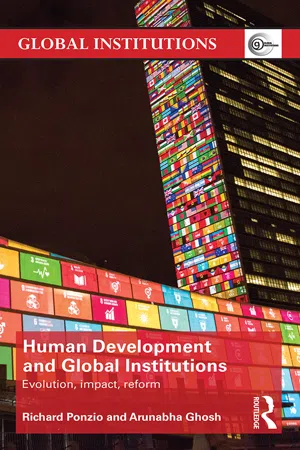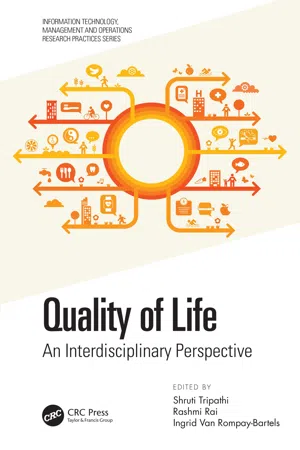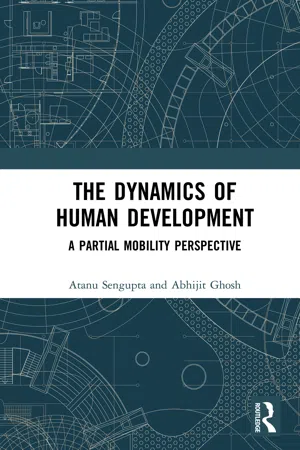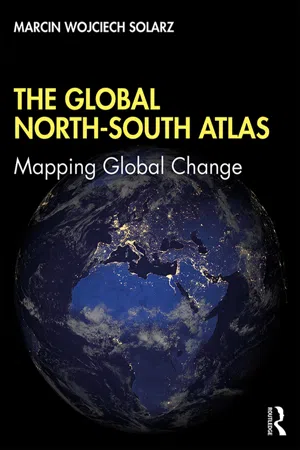Human Development Index
The Human Development Index (HDI) is a composite measure of a country's average achievements in key dimensions of human development, including health, education, and income. It provides a broader understanding of a country's development beyond just economic indicators, allowing for comparisons between nations and tracking progress over time. The HDI is widely used to assess and compare the overall well-being of different populations.
7 Key excerpts on "Human Development Index"
- eBook - ePub
Human Development and Global Institutions
Evolution, Impact, Reform
- Richard Ponzio, Arunabha Ghosh(Authors)
- 2016(Publication Date)
- Routledge(Publisher)
...In measuring the average achievements in a country in three basic dimensions of human development—a long and healthy life, access to knowledge, and a decent standard of living (elaborated further below)—the HDI, like other measures, also does not take into account the full meaning of development. However, it does represent a radically significant improvement over earlier economic-centric measures. 2 Employing calculations based on data from leading international data agencies (including the International Monetary Fund and Organisation for Economic Co-operation and Development) and other credible data sources, the HDI is the most widely cited aspect of a global HDR, whether by international policy-makers, scholars, or journalists. Cross-country comparisons fuel vigorous debates within and between each of these groups on whose country is ahead, whose country is behind, and what the primary factors are that contribute to a country’s overall ranking, particularly in relation to the performance of neighboring countries. 3 Besides the chief architect of the HDR s—Mahbub ul Haq—Amartya Sen, Sudhir Anand, and Meghnad Desai 4 were instrumental in the conceptualization of the HDI as a composite statistic of human well-being. Worried about the challenges of reflecting the full extent and complexity of human capabilities in a single index, Sen initially opposed the HDI, writing in later years: Sen eventually came around when Haq convinced him of the value of a single number for focusing the attention of international and national policy-makers, as well as shifting their attention away from narrow economic concerns to a broad focus on major factors contributing to and reflecting advances in human progress. Sen also appreciated that “you could not pick-and-choose” variables arbitrarily (e.g., choose health at the expense of education or economic factors) and that, while still crude, the HDI was a more comprehensive measure than GNP...
- eBook - ePub
Quality of Life
An Interdisciplinary Perspective
- Shruti Tripathi, Rashmi Rai, Ingrid Van Rompay-Bartels(Authors)
- 2021(Publication Date)
- CRC Press(Publisher)
...2020). Citizens of such developed societies are increasingly questioning the status quo perceptions about the achievement of economic progress and development at all cost; instead, there is movement among the citizens towards a preference for a fairer and just society, and advocacy for climate [Social and global justice (OECD 2019)]. However, while waves of government and policy disapprovals sweep across countries of varying stages of national development—potentially highlighting issues with human development and the need to address the contemporary relevance of the HDI (UNDP 2019; Repucci 2020)—it might first be appropriate to address what the authentic intent of the HDI is. Designed as a balanced approach for the measure of a country’s development, the HDI has been a prominent alternative to the gross domestic product (GDP), which merely functioned as a perennial unidimensional measure of national development (Sagar and Najam 1998). In recognition of the importance of enlarging choices of people in leading a long and healthy life, acquiring knowledge through education and having access to resources to achieve a decent standard of living, the HDI was initially developed to measure human development of a country along the lines of these considerations for a quality of life (UNDP 1990; Sagar and Najam 1998). The index was intended as a mechanism for comparing progress in human development by moving the debate on development beyond economic measures (Morse 2003b). Presently, the motion could be considered successful as many countries are now measured beyond GDP per capita in the UNDP Human Development Reports. Even though the HDI is a well-known yardstick of well-being (Klugman et al. 2011), it has remained a controversial indicator of human development since its inception in 1990 with arguments for its flaws and redundancies (McGillivray 1991; Cahill 2005)...
- J. Edward Taylor, Travis J. Lybbert(Authors)
- 2020(Publication Date)
- University of California Press(Publisher)
...He felt this was necessary in order “to shift the focus of development economics from national income accounting to people-centered policies.” 1 The measure Haq proposed had to be simple to understand, and it had to encompass both economics and human well-being. Above all, it had to be an index, which would make it possible to compare improvements in well-being across countries. Amartya Sen provided the conceptual framework for this project. Actually, Sen initially opposed the idea, worrying that it would be too difficult to capture the full complexity of human development in a single index. In the end, Haq swayed Sen by persuading him that only a holistic development index could shift policy makers’ and researchers’ attention from economics to human well-being. Only a concept that confronts GDP head-to-head, as a single number, could get real traction in the policy process. That is how the Human Development Index (HDI) was born. After considerable discussion and debate, the UNDP decided on an index that included the following economic and human outcomes: • Life expectancy at birth (years; LE); because it is measured at birth, this index is affected by high infant mortality rates in some countries. • Education, composed of two separate measures: expected years of schooling for children (EYSC) and mean years of schooling for adults (MYSA). By having a separate measure for expected education of children, this index can reflect improvements in low-education countries that invest in expanding educational opportunities for kids. Mean years of schooling for adults would reflect such improvements only after many years have elapsed. • Income (GNI), measured as the gross national income per capita, PPP adjusted to take into account cost of living differences among countries. Table 6.1 shows the highest and lowest outcomes for each of these variables across the globe in 2013. It reveals massive disparities in human development indicators...
- Eckhard Siggel(Author)
- 2016(Publication Date)
- Routledge(Publisher)
...Certainly, the HDI can be criticized for omitting some aspects and over-emphasizing or double-counting others, but it is a relatively complete measure that makes good use of widely available data. The indicator is computed for over 170 countries. Case Study 1 introduces the reader to the technical aspects of computation of the HDI, as well as to the changes in methodology it has undergone since it was first published. References Ahluwalia, M.S. and H. Chenery (1974), ‘A Model of Distribution and Growth’, in: Chenery et al. (eds.), Redistribution with Growth, The World Bank, Oxford University Press. Kravis, I., Heston, A. and Summers, R. (1978), International Comparisons of Real Product and Purchasing Power, Baltimore, Johns Hopkins Press. Kuznets, Simon (1955), ‘Economic Growth and Inequality’, American Economie Review, 45, no. 1. Morris, David (1979), Measuring the Condition of the World’s Poor. The Physical Quality of Life Index, New York, Pergamon Press for the Overseas Development Council. Sen, Amartya (1989), ‘The concept of development’, Chenery and Srinivasan (eds.), Handbook of Development Economics, vol.1, North Holland, pp. 9–26. United Nations Development Program (UNDP, 1990), Human Development Report, New York, Oxford University Press. UNDP (1995), Human Development Report, New York, Oxford University Press. World Bank (2002 and 2003), World Development Reports 2002 and 2003, Washington, Oxford University Press. Case Study 1 The Human Development Index: Kenya, Mexico and Canada Purpose The purpose of this first case study is to acquaint students with the difficulties of computing indicators of development. By calculating the UNDP-sponsored Human Development Index (HDI) for three countries and two time periods, students will not only understand the mechanics of this indicator but also see its problems and limitations. The HDI is to be computed using the simple method used in 1990 as well as the more sophisticated version of 1992...
- eBook - ePub
The Dynamics of Human Development
A Partial Mobility Perspective
- Atanu Sengupta, Abhijit Ghosh(Authors)
- 2020(Publication Date)
- Routledge India(Publisher)
...The argument has been pushed forward by the new paradigm of human development that seeks to capture it quantitatively (Sen 1985, 1987; UNDP 1990; Haq 2004). A major breakthrough in these fields has been the publication of Human Development Report (HDR) by UNDP since 1990, where a single number has been estimated to capture the multidimensional socioeconomic status of a country. Human development is a broader concept that captures broader aspects of life that make it worth living. Generally, three dimensions are considered in this regard: a long and healthy life measured by life expectancy at birth, knowledge measured by two indices (expected years of schooling and mean years of schooling), and a decent standard of living measured by gross national income per capita in purchasing power parity (UNDP 2016). They are combined with proper weight to generate a unique scalar measure: the Human Development Index (HDI). These basic rights are defined to be essential and are by no means exhaustive. HDI is popular due to its simplicity even among policymakers. Despite the methodology of HDI, the estimation has received several criticisms (for details see Sen 2004a, 2004b; Fukuda-Parr and Kumar 2004; Raworth and Stewart 2004; Fukuda-Parr 2006; Haq 1995, 2004). However, in this book, our goal is neither to challenge the formulation of HDI nor to seek out its deficiencies. Traditional HDI literature has been primarily interested in static distributions corresponding to a particular point in time. The dynamic aspects of HDI have been a neglected area; it receives little systematic attention. The study in relative dynamics of HDI is still rarer. In this book we focus on the dynamic aspects of HDI using mobility literature from a partial perspective. 1.2 A discourse on positional objectivity In this book we analyse the mobility of HDI from a positional objectivity perspective rather than from an absolutist perspective. The distinction is due to Sen (1993)...
- eBook - ePub
Economics and History
Surveys in Cliometrics
- David Greasley, Les Oxley, David Greasley, Les Oxley(Authors)
- 2011(Publication Date)
- Wiley-Blackwell(Publisher)
...10). In other words, human development emphasizes positive freedom (Desai, 1991, p. 356). As a synthetic measure of human development, the UNHDI tries to capture a country’s achievements in longevity, knowledge and standard of living through various indices: the relative achievement in life expectancy at birth, in education and in ‘all dimensions of human development not reflected in a long and healthy life and in knowledge’ for which the adjusted per capita GDP (its logarithm) is a surrogate (UNDP, 2001, p. 240). These achievements provide individuals the freedom to choose (Kakwani, 1993; Fleurbaey, 2009) and, thus, the opportunity ‘to lead lives they have reasons to value’ (Sen, 1997). Indices for each dimension (I) are computed according to the following formula, (1) where x is the observed value of a given dimension of welfare, and Mo and M represent the maximum and minimum values, or goalposts. Goalposts representing levels not reached yet and below the present’s lowest level, respectively, were chosen for each indicator in order to make possible comparisons over time. 4 Each dimension ranges, thus, between 0 and 1. The UNHDI is obtained as the unweighted arithmetic average of the three dimension indices. Reactions to non-conventional indicators of well-being have always been critical. One of the most popular synthetic indices, Morris’s (1979) physical quality of life index (PIQL; an unweighted average of normalized indices of infant mortality, life expectancy and literacy) was seriously questioned on the basis of the high collinearity between its first two components (Hopkins, 1991) and has only made an uncritical comeback in the historical literature (Federico and Toniolo, 1991; Domínguez and Guijarro, 2000). 5 The UNHDI, presumably an improvement on Morris’s PIQL, has been seriously questioned (Dasgupta, 1993, p. 77). 6 Srinivassan (1994, p...
- eBook - ePub
The Global North-South Atlas
Mapping Global Change
- Marcin Wojciech Solarz(Author)
- 2019(Publication Date)
- Routledge(Publisher)
...The series related to the evolution of human development level encompasses all the countries in the world in the period 1980–2017 (five maps). HDI levels are marked with color and areas of circles correspond to the population(s) of the given country(ies) (in the case of previous series, GDP per capita and GDP respectively). This additionally allows quality of life to be examined not only through the prism of states but also in societies. This series is the shortest, as the history of HDI only dates back to 1990, and historical analyses of human development have only been conducted over a limited time period. It should be emphasized that an accurate reading of the maps in this chapter requires a thorough reading of both the legend (the four series of maps for GDP and GDP per capita have a common legend (Figure 1.1), as do the maps in the HDI series (Figure 1.57); the exception being maps for 2017, which have their own legends (Figures 1.54 and 1.62), and a separate introductory map that has been inserted into each series (with the exception of human development maps showing data for all the countries of the world) to illustrate the way(s) in which the data were geographically aggregated, i.e. to depict the regions described by the data (Figures 1.3, 1.20, 1.35, 1.46). FIGURE 1.1 A common legend for all series of maps showing GDP and GDP per capita (1 ad –2008) Source : Own elaboration Any attempt to show world development over the past 2000 years is fraught with risk. During this time, a great many polities have risen and fallen and political boundaries have changed radically. Moreover, the essence and understanding of development have changed. The more distant the past, the fewer the hard figures, and the more uncertain, questionable, and debatable the estimates and hypotheses...






